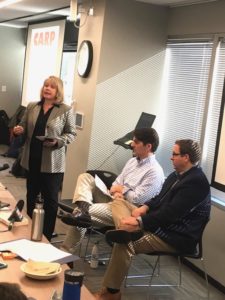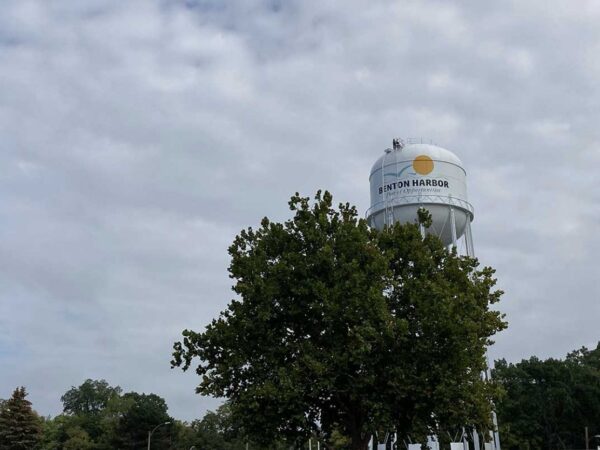
The Asian carp advance toward the Great Lakes first gained wide notice in the early 2000s, and an electrical barrier deterrent was installed in the Chicago area waterways system.
Since, additional barriers have been added, state and federal agencies have fishing programs to reduce the population and infrastructure modifications to the waterways have been considered as additional deterrents.
This week, Great Lakes Now joined a group of journalists on a two-day trip to the Illinois and Chicago rivers to get the latest in the Asian carp fight. The outing is sponsored by the Institute for Journalism & Natural Resources.
It has been nine years since the possible presence of Asian carp past the electrical barriers designed to keep them out of Lake Michigan was first detected with environmental DNA—or eDNA —and experts and advocates remain divided on the best way to keep the carp at bay.
That divide was on full display this week in Illinois when visiting journalists toured the front lines of the carp fight, getting a briefing on commercial fishing designed to remove carp from the path to Lake Michigan and an update on the effectiveness of the electrical barriers.
Both are stopping the carp advance, according to representatives of the U.S. Geological Survey and the Army Corps of Engineers, Great Lakes Now reported earlier this week.
But a Michigan Department of Natural Resources representative and two long-time Great Lakes environmental advocates painted a different picture in a separate briefing for the journalists.

Tammy Newsome, MDNR; Joel Brammeier, Alliance for the Great Lakes and Marc Smith, National Wildlife Federation, Photo by Gary Wilson
MDNR’s Tammy Newcomb, the Alliance for the Great Lakes’ Joel Brammeier and the National Wildlife Federation’s Marc Smith presented a united front saying that while a part of the fight, commercial fishing and the electrical barriers can’t be the primary deterrents to keep carp out of Lake Michigan.
Previous attempts to establish markets for Asian carp supported by commercial fishing have failed, Brammeier said, therefore there is no reason to believe future attempts would succeed.
All three expressed belief that positive tests for eDNA past the electrical barriers are more of an indicator of the presence of Asian carp than U.S. Fish and Wildlife Service staff are willing to concede. In early October a substantial number of positive hits were found in the Chicago River south of downtown. The agency is still investigating the results of that testing.
But the trio of advocates was primarily pitching a solution, the proposed $831 million modification to the Brandon Road lock—currently the proposed choke point to stop the carp.
Michigan in the administration of former Gov. Rick Snyder was a big supporter of the lock modification and he urged his Great Lakes colleagues to follow his lead. Newcomb reiterated that support under Gov. Gretchen Whitmer includes a pledge of financial support to help Illinois offset some of the costs it would incur for the lock.

Amy McGovern, U.S. Fish and Wildlife Service explaining eDNA testing in the Chicago River, Photo by Gary Wilson
Smith said approval of the lock modifications should be seen as a national priority given the spread of carp to Kentucky and areas of the South. The advocates hope that Kentucky Sen. Mitch McConnell, the senate majority leader, will use the gravitas of his office to advance funding, according to Smith.
Illinois Gov. J.B. Pritzker can greenlight the initial design stages of the Brandon Road project by signing a contract with the Army Corps to be the non-federal partner, Brammeier said, and he has been making that case to the governor’s office.
Pritzker is being cautious, according to Brammeier, because the governor is concerned about the overall cost of the Brandon Road project and its impact on Illinois.
Illinois is still in the early stages of a financial recovery and Pritzker, in an April 2019 letter to the Army Corps, said he would not sign a partnership agreement “without a cost control strategy.”
At the Army Corps briefing for the visiting journalists on Monday, it was revealed that the final cost estimate to modify Brandon Road had again escalated from $778 million to $831 million.
The original 2017 estimate for the plan was $275 million and the project still needs approval and to be funded by congress. It is estimated that modifications could be complete by 2027.
Watch Great Lakes Now’s segment on Asian carp here:
Read additional Great Lakes Now reporting on Asian carp here:
 Siege: Asian carp at the gates of the Great Lakes
Siege: Asian carp at the gates of the Great Lakes
Featured Image: Map showing locations of key features, or measures, of the tentatively selected plan at Brandon Road Lock and Dam. Image by USACE




